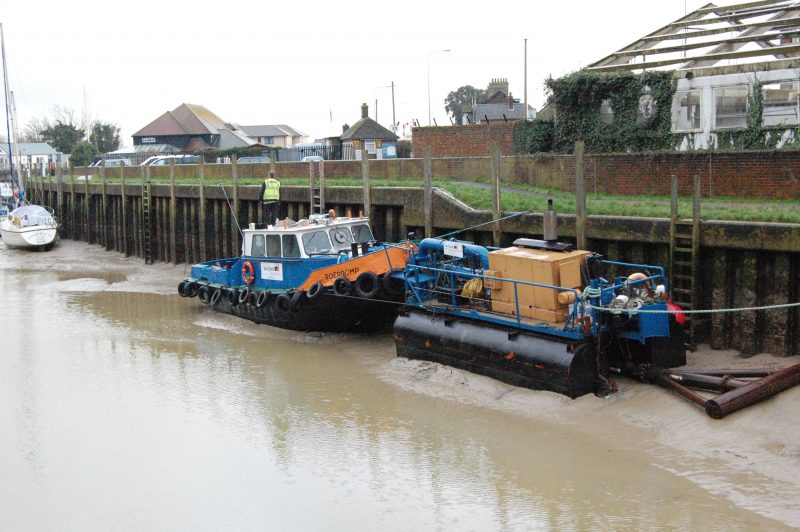Dredging operations are due to start at Strand Quay next week. The Roerdamp-Baladur nosed its way up Rock Channel at high tide on January 6, and moored on the Winchelsea side below the dilapidated shell of the Grist Mill Pine shop. The Environment Agency has ensured that the channel is almost completely clear of shipping, giving the dredger a clear run on either bank. Starting on January 19, Strand Quay, Rock Channel and the turning area at Rastrum’s wharf will be cleared in seven days over 14 tides, operating either side of high water, according to Deputy Harbour Master Karl Sandercock.
Skipper Shawn Brown explained the working procedure and the hydro-technology involved: the method uses high-volume, low-pressure water injection into the mud banks either side of the channel. The vessel works its way up and down the river, pumping jets of water through a T-bar into the mud, churning it up. The silt is resuspended and the sediment mixture formed into a density current to be carried downstream and out to sea by tidal and gravitational forces assisted here by the opening of the River Tillingham sluice.
While the operation is simple in concept, the technology behind the control system is highly sophisticated. An on-board computer uses GPS, the global positioning system, to monitor the exact location of the vessel in the river and also to control the depth of the injection beam underneath the vessel in relation to OD (ordinance datum) levels. It can operate in water depth of up to six and a half metres.
The dredger is the smallest vessel of its type in the Van Oord fleet and is particularly suited to work in small, shallow ports and marinas. Its good manoeuvrability enables it to work very close to embankments and quay walls, as here at Rye. “The Roerdamp was the founding vessel of water-injection dredging technology,” said project manager, Godfried van Oord, at his office at Jury’s Gap. “It’s now 25 years old and still going strong.”
Regular dredging is necessary to prevent silting up of the waterway and this is the vessel’s fourth visit to Rye, he said. His response to the question: “Why doesn’t all that mud end up on Camber beach?” was reassuring. “The sediment seeks out a high-energy environment,” he replied, “and finds its way into deep water.” In former times, the mud was scooped out and spread direct on to agricultural land, but environmental concerns about metal and chemical content now rule this out as an acceptable disposal method.
The family-owned business of international dredging and offshore contracting was founded by Godfried van Oord’s great grandfather in 1868. Based in Rotterdam, Holland, it now spans the globe. He is one of eight family members active in the firm, and is responsible for managing the Environment Agency project for sea defences along a 1,700 metre stretch of coastline at Broomhill, near Camber.
The current phase calls for the depositing of Norwegian granite-like mineral called Larvikite, at the base of the embankment on the seaward side. It is transported by barge across the North Sea, 25,000 tonnes at a time, 265,000 tonnes in total, to provide a rock armouring to the foot of the sea defences. A smaller barge brings it to shore, as reported in Rye News (see Rock on Charlie: get the job done). The project scope also includes the beach-feeding of a further 700 metres, similar to the long-running operation being carried out at Rye Harbour. The sea defence work started on site at Broomhill on August 1 last year and is expected to be completed by December 1, this year.



